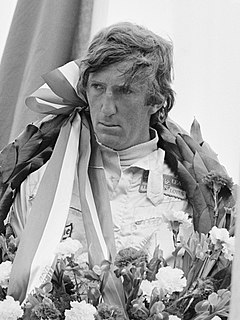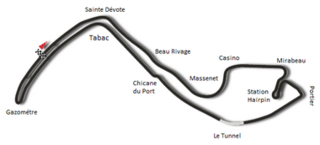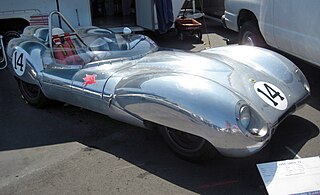Brabham is the common name for Motor Racing Developments Ltd., a British racing car manufacturer and Formula One racing team. Founded in 1960 by two Australians, driver Jack Brabham and designer Ron Tauranac, the team won four Drivers' and two Constructors' World Championships in its 30-year Formula One history. Jack Brabham's 1966 FIA Drivers' Championship remains the only such achievement using a car bearing the driver's own name.

Karl Jochen Rindt was a German-born racing driver who represented Austria during his career. In 1970, he was killed during practice for the Italian Grand Prix and became the only driver to be posthumously awarded the Formula One World Drivers' Championship.

Brands Hatch is a motor racing circuit in West Kingsdown, Kent, England. First used as a grasstrack motorcycle circuit on farmland, it hosted 12 runnings of the British Grand Prix between 1964 and 1986 and currently hosts many British and International racing events. The venue is owned and operated by Jonathan Palmer's MotorSport Vision organisation.

The 1958 Monaco Grand Prix was a Formula One motor race held on 18 May 1958 at Monaco. It was race 2 of 11 in the 1958 World Championship of Drivers and race 2 of 10 in the 1958 International Cup for Formula One Manufacturers. The race was the 16th Monaco Grand Prix and was held over 100 laps of the three kilometre circuit for a total race distance of 314 kilometres.

The 1968 Belgian Grand Prix was a Formula One motor race held at the Spa-Francorchamps Circuit on 9 June 1968. It was race 4 of 12 in both the 1968 World Championship of Drivers and the 1968 International Cup for Formula One Manufacturers. The 28-lap race was won by McLaren driver Bruce McLaren after he started from sixth position. Pedro Rodríguez finished second for the BRM team and Ferrari driver Jacky Ickx came in third.

The 1969 Monaco Grand Prix was a Formula One motor race held at the Circuit de Monaco on 18 May 1969. It was race 3 of 11 in both the 1969 World Championship of Drivers and the 1969 International Cup for Formula One Manufacturers.

The 1970 Monaco Grand Prix was a Formula One motor race held at the Circuit de Monaco on 10 May 1970. It was race 3 of 13 in both the 1970 World Championship of Drivers and the 1970 International Cup for Formula One Manufacturers. Jochen Rindt scored the last victory for the famous Lotus 49.
The 1968 Formula One season was the 22nd season of the FIA's Formula One motor racing. If featured the 19th FIA World Championship, which commenced on 1 January 1968, and ended on 3 November after twelve races, and numerous non-championship races.
The 1966 Formula One season was the 20th season of FIA Formula One motor racing. It featured the 1966 World Championship of Drivers and the 1966 International Cup for F1 Manufacturers which were contested concurrently over a nine-race series that commenced on 22 May and ended on 23 October. The season also included a number of non-championship races for Formula One cars.
The 1960 Formula One season was the 14th season of the FIA's Formula One motor racing. It featured the eleventh FIA World Championship of Drivers, the third International Cup for F1 Manufacturers and numerous non-championship Formula One races. The World Championship commenced on 7 February 1960 and ended on 20 November after ten races. Jack Brabham won his second consecutive title with his Cooper team defending its constructors' title.
Ian Ewart Raby was a British racing driver from England. He participated in 7 World Championship Formula One Grands Prix, debuting on 20 July 1963 in the British Grand Prix, where he retired on Lap 60. He scored no championship points. He was a garage-owner in Brighton, Sussex trading as Empire Cars Ltd. As a privateer he came to Formula One late in life.
Ivor Léon John Bueb was a British professional sports car racing and Formula One driver from England.
Rob Walker Racing Team was a privateer team in Formula One during the 1950s and 1960s. Founded by Johnnie Walker heir Rob Walker (1917-2002) in 1953, the team became F1's most successful privateer in history, being the first and only entrant to win a World Championship Formula One Grand Prix without ever building their own car.

Ecurie Ecosse was a motor racing team from Scotland. The team was founded in November 1951 by Edinburgh businessman and racing driver David Murray and mechanic Wilkie Wilkinson, its most notable achievement was winning both the 1956 and 1957 24 Hours of Le Mans. The team also raced in three Formula One races. Ecurie Ecosse's cars were always distinctive in their Flag Blue Metallic paint.

The Cooper T51 was a Formula One and Formula Two racing car designed by Owen Maddock and built by the Cooper Car Company for the 1959 Formula One season. The T51 earned a significant place in motor racing history when Jack Brabham drove the car to become the first driver to win the World Championship of Drivers with an engine mounted behind them, in 1959. The T51 was raced in several configurations by various entrants until 1963 and in all no less than 38 drivers were entered to drive T51s in Grand Prix races.
The 2nd Cornwall MRC Formula 1 Race was a motor race, run to Formula One rules, held on 2 August 1954 at the Davidstow Circuit, Cornwall. The race was to be run over 30 laps of the little circuit, but this was reduced to 20 laps due to the bad weather. The race was won by British driver John Coombs in a Lotus Mk VIII.
Davidstow Circuit is a disused motor racing circuit and airfield built in Cornwall, in the United Kingdom. The circuit was built on the site of a World War II RAF Coastal Command base, RAF Davidstow Moor, opened in 1942. Davidstow circuit opened in 1952, and held three Formula 1 races between 1954 and 1955. The circuit hosted its last race in 1955, and was one of many of Britain's airfields to be transformed into motor racing venues. Davidstow circuit is notable for the first victory in a Formula One race by a Lotus.
The 3rd Lombank Trophy was a motor race, run to Formula One rules, held on 14 April 1962 at Snetterton Motor Racing Circuit, England. The race was run over 50 laps of the circuit, and was won by British driver Jim Clark in a Lotus 24.




















